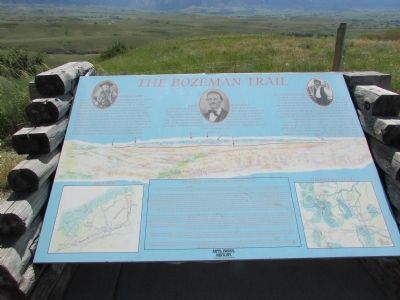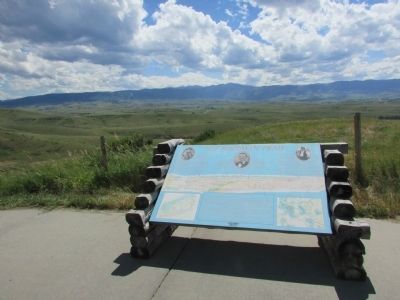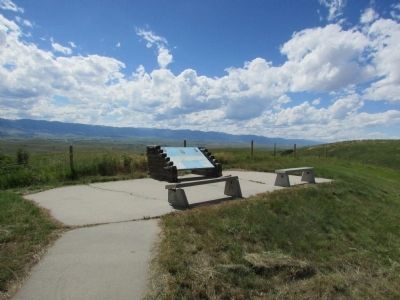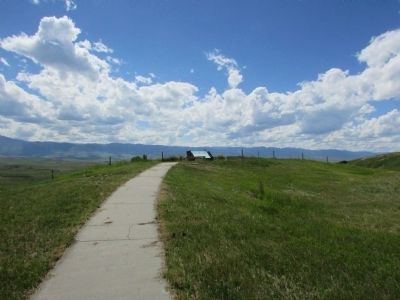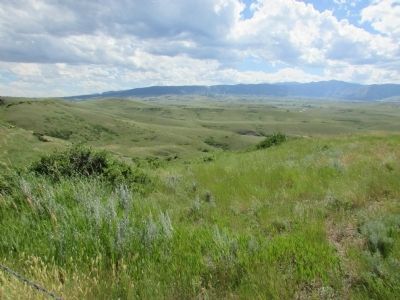Sheridan in Sheridan County, Wyoming — The American West (Mountains)
The Bozeman Trail
Jim Bridger first came west in 1822, working in the fur trade until that industry declined. He traveled throughout the west, becoming an expert on the Indians and the land. After working as a trader, he established the Bridger Trail through the Big Horn Basin in 1864. During his last years on the frontier, he served as a scout for the army, including the Connor Expedition and at the Bozeman Trail forts until late 1867, returning once more in 1868 to help in the abandonment of the posts. He may have warned Fetterman about the dangers of underestimating the Indians’ fighting abilities.
John Bozeman left Georgia in 1860 for the gold fields of Colorado, and on to the new mines in Montana in 1862. In 1863 Bozeman and John Jacobs established the route that became known as the Bozeman Trail. Bozeman himself led only one wagon train up the trail in 1864. In 1867, he was killed by Indians in Montana, leaving as his legacy the town of Bozeman, Montana and the trail named for him.
Elsa Spear Byron Born into a pioneer family in 1896, Elsa Spear spent her life documenting and preserving the history of the American West, with her greatest interest being the Bozeman Trail and its route through the drainage area of her beloved Goose Creek. A talented photographer, she left a legacy of pictures from the early twentieth century focusing primarily on Indians, cowboys and landscapes that are especially admired today. She researched and wrote about the event along the Bozeman Trail, and was always willing to share her knowledge with others. Elsa passed away in 1992, ending a living link between the western frontier and the modern world.
The Bozeman Trail and the Goose Creek Valley
The view you see before you is the Goose Creek Valley. In the mid 1800’s, this valley was still wild and open land travelled only by the Northern Plains Indian Tribes and a few trappers and traders, following centuries old trails along the east slope of the Big Horn Mountains. Here the Lakota, Cheyenne, Arapaho, Crow and Shoshone hunted the great migrating Bison herds and fought one another for dominance.
In 1863, John Bozeman and John Jacobs staked out the last great overland emigrant route, establishing a trail between the goldfields of southwestern Montana and the Oregon/California Trail along the Platte River. This route, known as the Bozeman Trail or the Montana Road, followed the same ancient north-south trails the Native Americans had used for hundreds of years. The emigrants that came up the new trail soon alarmed the Lakota and their allies, the Cheyenne and Arapaho. They had seen the devastation emigrants on the Oregon/California Trail had inflicted on the natural resources they needed for their way of life, and they were determined to protect this last great open hunting ground. Clashes between travelers and Indians on the Bozeman Trail and warfare to the south along the Platte River brought the United States Army into the conflict. In 1865, the Connor Expedition concluded in an attack on an Arapaho village on Tongue River, a few miles north of here near present day Ranchester. In 1866, The Army established posts along the Bozeman Trail, resulting in “Red Cloud’s War,” which lasted until 1868. The three forts, Reno, Phil Kearny, and C.F. Smith, were all frequently harassed by Indian attacks, but Fort Phil Kearny was the largest and most hated. Three great battles were fought along the Bozeman Trail. The Fetterman Fight on December 21, 1866 and the Wagon Box Fight on August 2, 1867 were fought near Fort Phil Kearny, while the Hayfield Fight on August 1, 1867 took place near Fort C.F. Smith. The tribes won this war, but eventually lost the peace. The Fort Laramie Treaty of 1868 closed the Bozeman Trail, ordered the Army to abandon the forts, and made the lands between the Black Hills and the Big Horns “unceded Indian territory.” It also assigned the Lakota and other tribes to specific reservations, sowing the seeds for future conflict.
The Native Americans roamed and hunted in the Goose Creek Valley for another eight years. In December 1875, the U.S. Government ordered all the tribes to leave the “unceded Indian territory” and return permanently to their reservations by January 31, 1876. Any Indian outside the reservations would be considered hostile, and subject to military action. This order, combined with the discovery of gold in the Black Hills, the heart of the Lakota Reservation, led to conflict once more. As part of the Army’s campaign to force the Indians onto reservations, General George Crook led a column of soldiers up the Bozeman Trail, and warfare returned to the Goose Creek Valley. Crook established his command’s camp near the confluence of Big and Little Goose Creeks at the location of present-day Sheridan, and marched north to find those Indians refusing the reservation order. On June 17, the Indian forces fought Crook to a standstill at the Battle of the Rosebud, forcing him to return to his Goose Creek Camp. A week later the Indians defeated Custer whose Seventh Cavalry was part of a second column under overall command of General Alfred Terry, at the Little Bighorn. However, the Lakota, Cheyenne and Arapaho were eventually crushed by military campaigns during the following winter, and forced onto the reservations. This valley was now open to settlement by the westward flow of emigrants.
Further south along the foothills, the frontier town of Buffalo was founded in 1877, near the new military post Fort McKinney. Settlers soon moved into the Goose Creek Valley, with the town of Big Horn being established in Little Goose in 1881 followed by Sheridan in 1882. Successful ranching, farming and coal mining began to grow, and the local economy and population expanded rapidly after the railroad came to Sheridan in 1892. The establishment of Fort Mackenzie in 1899 as one of the last “frontier” posts brought another major economic resource to the valley.
Today, agriculture, coal mining, the railroad and the Veterans Administration Hospital at Fort Mackenzie continue to be major occupations for the residents of the Goose Creek Valley, as is the growing tourism industry. Travelers along Interstate 90 follow much the same trail as the Indians, John Bozeman, soldiers and pioneer emigrants used many years ago. The great Bison herds are gone, but the wide beauty the Indians fought to preserve still reflects through the modern landscape of ranches and towns.
Erected by Wyoming Department of State Parks and Cultural Resources.
Topics. This historical marker is listed in these topic lists: Exploration • Wars, US Indian. A significant historical date for this entry is January 31, 1876.
Location. 44° 42.062′ N, 106° 54.584′ W. Marker is in Sheridan, Wyoming
, in Sheridan County. Marker is on Interstate 90, on the right when traveling south. Marker is located in a pullout on the southbound side of I-90. Touch for map. Marker is in this post office area: Sheridan WY 82801, United States of America. Touch for directions.
Other nearby markers. At least 8 other markers are within 8 miles of this marker, measured as the crow flies. Sheridan (within shouting distance of this marker); Big Horn Blacksmith Shop (approx. 4.3 miles away); Bozeman Trail Blacksmith Shop (approx. 4.3 miles away); a different marker also named Bozeman Trail (approx. 4.4 miles away); First Cabin in Sheridan (approx. 7.2 miles away); A Place of Shelter (approx. 7.3 miles away); General George Crook (approx. 7.4 miles away); Big Horns (approx. 7.4 miles away). Touch for a list and map of all markers in Sheridan.
More about this marker. Portraits of Jim Bridger, John Bozeman and Elsa Spear Byron appear at the top of the marker. Maps of the area of the marker and the Bozeman Trail can be seen at the bottom of the marker. Another map helps identify sites that can be seen from the marker. These include Fort Phil Kearny, the town of Story, Cloud Peak, Little Goose Peak, Red Grade, Bighorn and Dayton.
Credits. This page was last revised on June 16, 2016. It was originally submitted on July 26, 2015, by Bill Coughlin of Woodland Park, New Jersey. This page has been viewed 581 times since then and 34 times this year. Photos: 1, 2, 3, 4, 5. submitted on July 26, 2015, by Bill Coughlin of Woodland Park, New Jersey.
